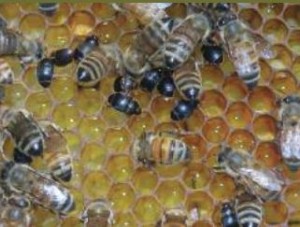Small Hive Beetle arrives in Europe
Update 2 Dec 2014: See Beetle Blaster, a device to control Small Hive Beetle.
Update 24 Sep 2014: There has been a fourth sighting of Small Hive Beetle in southern Italy near the first 3 sightings. A 5th is under investigation.
The Small Hive Beetle (SHB), Aethina tumida, damages comb, stored honey and pollen and can be a major threat to the beekeeping economy. The beetles multiply quickly and the larvae tunnel through brood, eating as they go and ultimately wiping out the colony. Once established, it cannot be eradicated.
SHB was spotted in a university bait hive in Italy, in Reggio Calabria, opposite Sicily. Professor Vincent Palmeri of the University of Reggio Calabria said in a report in Apitalia that he found the beetle in three small swarms near the port of Gioia Taura. He couldn’t be sure that the beetle had arrived with the bees as the beetle typically moves in fermented rotting fruit. And since SHB can survive without food for 120 days, there could be several plausible explanations of its appearance.
Professor Palmeri expressed concern at its possible spread throughout country because migratory beekeeping is common in that part of southern Italy. He has urged beekeepers to be on high alert. He does not discountb the possibility that SHB may already be widespread spread in southern Italy and that beekeepers may be fearful in reporting it.
Dr Max Watkins, Technical Director of Vita (Europe) Ltd said «As yet there is no foolproof way of protecting bees from the Small Hive Beetle and it has proved impossible to eradicate them once they have become established. Interestingly, its impact has varied in the different parts of the world it has invaded. In the USA it can be devastating, but in Australia the damage caused by this pest has not been as extensive or severe as in southern USA, although it remains a serious threat. If it does become established in Europe, the full extent of its impact cannot really be predicted. Vita is of course monitoring the situation closely and will continue its investigations into possible control mechanisms.»
The appearance of SHB in Italy seems much more serious than its earlier arrival in Portugal when it was immediately eradicated from an imported consignment of queens from Texas.
SHB is a native of sub-Saharan Africa, but appeared in the USA in 1998, spreading through several states, into the Caribbean, Canada and as far as Hawaii. In its native African home, it is a minor pest as the indigenous bees can defend against it.
The authorities in nearly all countries will want to know of any suspected sightings of SHB. In the UK, SHB is a legally «notifiable» pest and British beekeepers suspecting the beetle’s presence should immediately inform the National Bee Unit of their concerns.
There is a detailed description of the pest and its life cycle on Beebase.

